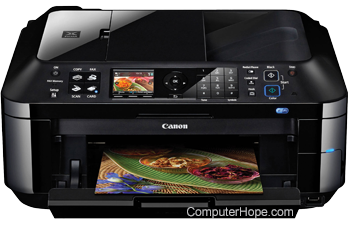How to troubleshoot a printer for hardware or software issues

When a printer cannot print, it's a good possibility that either the printer is experiencing a hardware or software issue. Before testing the software, it is always recommended that the printer is tested for hardware issues first.
Testing hardware
Follow these steps to troubleshoot your printer's hardware.
- Check that paper is loaded and that there are no paper jams.
- Check the cable connections. Both the power cable and data cables (e.g., USB cable) going from printer and to your computer.
- Verify that the printer power indication light is turned on or illuminated.
- Verify that the printer has no flashing lights or red or orange lights. It is common for printers to have red, orange, or any other flashing lights when the printer is malfunctioning.
- Run a self-test on the printer. Running a self-test should print a basic page of information indicating the printer is physically working. Your user's manual should have the instructions for printing a self-test. If your printer does not print a self-test, it's possible there is a defect or misconfiguration with your printer. We recommend you contact the printer manufacturer for help.
Testing software
Follow these steps to test the software on your computer that connects to the printer.
Windows users
- If possible, make sure your printer can print using the above hardware tests.
- Install the printer software provided with your printer. If no software was provided with your printer, see the printer drivers page for a listing of printer drivers. Drivers are required for your printer to work properly with the operating system.
- Click Start, Settings, Printers. In the printers window, verify your printer manufacturer and model is listed.
- Print a test page by right-clicking the printer icon and click the Properties option and click print test page. If the test page does not print, download the latest drivers from your printer manufacturer. For a list of printer drivers, see our printer drivers index.
- If the page prints successfully, open the printers window, right-click the printer and ensure that there is a check next to Set as default. Newer versions of Windows also show a check next to the printer icon once it is set as the default printer.
- Once the printer is set as default, click Start, Run, type notepad, and press Enter. In Notepad, type a test message and click File and Print. If the printer can print successfully from Notepad, but cannot print from another program, that program likely has an issue and not your printer.
Windows 2000, XP, Vista, 7, and 8 users
Older printers that worked in previous versions of Windows may no longer work in new versions. If your printer worked in a past version of Windows, but isn't working with a new one, contact the printer manufacturer to learn your options.
MS-DOS, Windows 3.x, Windows 95 users
Open the command line, and type the following two commands. Press Enter after each command to run it.
cd \
dir > lpt1
Your printer immediately begins printing the directory listing.
If your printer prints it, we recommend you reinstall your printer drivers. If your printer does not print and you have performed the hardware tests, your printer or the cables are likely bad. Contact your printer manufacturer for additional support and repair.
